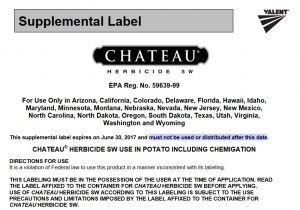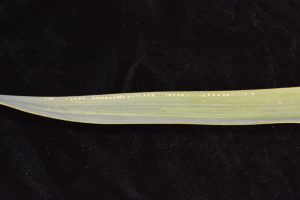As of Friday, April 21, we confirmed that ALM is in south Jersey and it is likely that it can be found throughout the state. Infested field chives were found in East Vineland as well as in backyard chives in Atlantic County and onion sets in the Middlesex/Monmouth County area. Feeding scars have been found in wild garlic which is abundant in New Jersey. So far, adult flies have only been trapped in chives. Given how chives are harvested, it is difficult to assess how damaging the fly will be to the chive crop. More of a problem will be protecting longer term crops like leeks and onions. [Read more…]
Vegetable Crops Edition
Seasonal updates and alerts on insects, diseases, and weeds impacting vegetable crops. New Jersey Commercial Vegetable Production Recommendations updates between annual publication issues are included.
Subscriptions are available via EMAIL and RSS.
Quick Links:
 NJ Commercial Vegetable Production Recommendations
NJ Commercial Vegetable Production Recommendations
 Rutgers Weather Forecasting - Meteorological Information important to commercial agriculture.
Rutgers Weather Forecasting - Meteorological Information important to commercial agriculture.
Update on Use of Chateau for Weed Control in Potato

Chateau herbicide has a supplemental label for application to potatoes after hilling for preemergence suppression of various broadleaf weed species. This supplemental label will expire on June 30, 2017 and Chateau must not be used on potato after this date.
This supplemental label will not be renewed by Valent as the company is in the process of putting this supplemental label on the federal label. However, this use for potatoes will show up on the revised federal label when it reissues from the EPA.
We currently do not have a time frame for that but it probably will not before June 30. We are expecting that the revised federal label will be issued prior to the use season next year.
Allium Leafminer Alert II in New Jersey
A survey of fields from Princeton/Pennington in Mercer County northward through Milford and Asbury (Hunterdon County) and east to Chester in central Morris Co. revealed heavy allium leafminer feeding and active adults in chives only. There was only one garlic plant at the Pennington site that had feeding signs. Yellow sticky cards from chive plots in the Princeton area had numerous adults, but cards from a garlic field in Pennington did not have leafminers despite being within 200 yards of an infested chive plot.
At this point, allium leafminer adults appear to be favoring chives for feeding and egg laying. As one of the earliest and most succulent allium leaf types, chives may be a good indicator of the onset of adult activity, and could be useful as we decide when to begin protecting our other allium crops, including overwintered leeks, garlic and onion plants now being transplanted. Because egg laying is now happening, the prudent course of action would be to protect these crops, either with row covers or with recommended insecticides. These include Trigard, Scorpion, Radiant and Entrust (OMRI-approved). For a complete list see the RCE Vegetable Crops Online Resource Center Critical Updates to the Mid-Atlantic Commercial Vegetable Recommendations.
If you wish to inspect crops in your area, start with chives. Observe the tallest leaves first, and look for lines of characteristic white spots. These are wounds made by the female as she pierces the leaves to lay eggs and extract plant sap on which to feed (see photo below).
As a review, allium leafminer has spread from Pennsylvania into New Jersey, New York, and Maryland. At present, the main area of infestation in New Jersey appears to be in the northern counties. Only one suspected fly has been caught (Fall, 2016) in southern New Jersey in East Vineland. Traps set in this southern area will be checked this week. The Vegetable IPM Program will continue to track the spread and population levels of ALM in New Jersey.
Allium Leafminer Alert in New Jersey
Numerous adult flies of the allium leafminer (ALM) have been found in field chives at an organic farm in Mercer County. The chives were near a high tunnel that had plant material where the flies had overwintered as pupae. Because of being in the high tunnel the flies emerged sooner than unprotected field populations. The adults apparently have been controlled by the farmer with an application of Pyganic.
Allium leafminer has spread from Pennsylvania into New Jersey, New York, and Maryland. At present, the main area of infestation in New Jersey is in the northern counties. Only one suspected fly has been caught (Fall, 2016) in southern New Jersey in East Vineland. We have set traps at several farms, mostly in the north, which will be checked this week. The Vegetable IPM Program will continue to track the spread and population levels of ALM in New Jersey.
Vegetable Disease Update – 4/17/17
Vegetable Disease Notes:
- Powdery mildew has been reported in a number of tomato greenhouse operations. For control of powdery mildew and other important diseases in greenhouses and high tunnels please see Table E14 on pages E52-E54 of 2016-2017 Commercial Vegetable Production Recommendations Guide.
- A new article on the importance of testing for Dickeya dianthicola in potato seed can be found here.
[Read more…]
East Vineland Vegetable Twilight Tuesday 4/25
Our annual Vegetable Integrated Crop Management Twilight Meeting is scheduled for Tuesday, April 25, 2017, 6:00 p.m. – 9:00 p.m. at the East Vineland Fire Hall, on Landis Ave. across from the Savoy Restaurant (use 4931 Landis Ave, Vineland, NJ 08360 for your GPS, and please park behind the building to enter conference room door in rear).
Agenda
Pesticide Recertification Credits have been requested for this meeting.
Hope to see you there!

